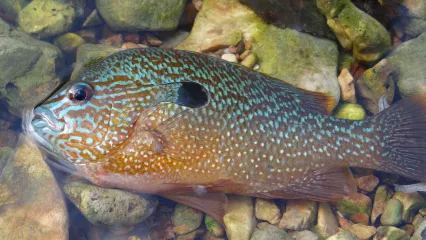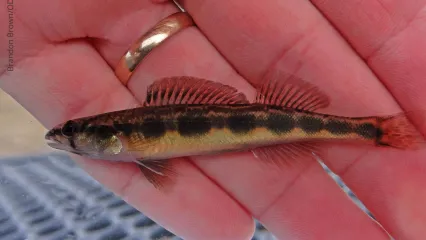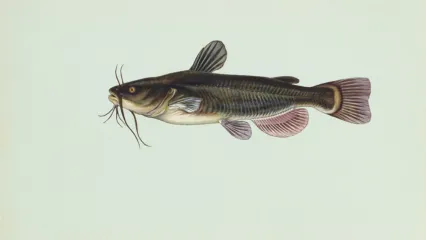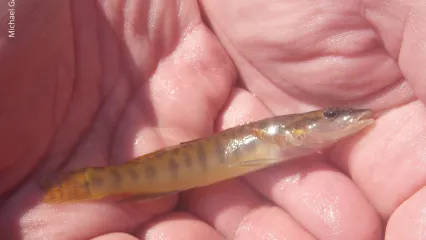
Description
Longear sunfish (Lepomis megalotis). like all sunfish , are well known to most young anglers as being the first "perch" ever caught on a cane pole with a dangling worm for bait Also dubbed "pan fish ," "goggle eye" and "bream," the name "perch" is inaptly applied to sunfishes, probably because of our European ancestors. Upon arrival to America, our immigrant forbearers found many unfamiliar but similar looking fish to those occurring back in their homeland. These new found fish needed a name; therefore, "perch" was applied to these small , lively and energetic little fish which now belong to the family Centrarchidae.
Longear sunfish are brilliantly painted in various hues of red, orange, yellow, blue and green. Named for their elongated gill cover that is typically bordered by white, longear sunfish get their scientific name, Lepomis megalotis, from the Greek word Lepomis, meaning "scaled gill cover," and megalotis, meaning "great ear."
Longear sunfish are known to everyone for their relatively small stature and abundant numbers. but they more than make up for their lack of size with their ferocity and willingness to bite a variety of small jigs, lures, spinner baits, spoons, plastics and artificial flies using light tackle and fly rods . This tasty fish also eagerly strikes many natural types of bait including worms , crickets, grasshoppers, and minnows suspended from bobbers. If you're looking for a new and exciting challenge, get out your ultra-light tackle, small baits and skillet and head to your nearest stream, lake or pond, where you will find fast paced action and fun for young and old alike in the form of longear sunfish!
Size
Adult longear sunfish average five to eight inches in length and normally weigh less than six ounces.
Habitat
Centrarchids are exclusive to North America and widely distributed statewide along the shallows of Oklahoma rivers , lakes, and ponds.
Life Cycle
Longear sunfish spawn in spring and early summer. They prefer to construct their nests in shallow substrates of pebbles, gravel and sand . The male constructs the nest using its fins to clear a circular depression and fan silt away It then locates a mate who lays sticky eggs in the nest and leaves. The male aggressively guards these eggs as the embryos develop. Newly hatched larvae dine on plankton and microscopic animals. Within two weeks, the larvae are herded into dense schools and into shallow water regions where they search for food and mature. As they continue to grow and approach adulthood, larger insects and even small fish become part of their diet.


